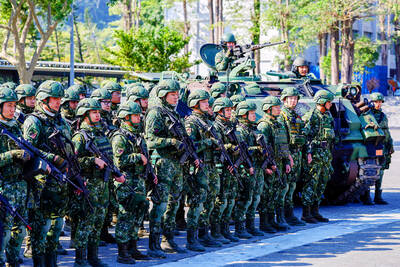A course on the languages and cultures of Taiwan at the University of California, Los Angeles (UCLA), has been taken by nearly 100 students in the past two years.
UCLA launched the Taiwan Studies Lectureship in 2014 and renewed it for another five years in 2020, said Pan Hui-chen (潘惠珍), education section secretary at the Ministry of Education’s Department of International and Cross-strait Education.
The program is supported by the Ministry of Education and organized by the UCLA Asia Pacific Center, Pan said.

Photo courtesy of the Ministry of Education
It encourages professors to develop Taiwan studies courses, invites visiting academics from Taiwan to be guest lecturers at UCLA, holds public events, makes library acquisitions, and provides research grants for faculty and graduate students to conduct research in Taiwan, the program’s Web site says.
The course “Languages and Cultures of Taiwan,” which was planned and designed by UCLA graduate Tsai Lin-chin (蔡林縉), was first offered in January 2020.
Students who enroll in the course are required to have taken Mandarin classes for at least a year.
The course compares Hoklo (also known as Taiwanese) with the Minnan languages used in Chinese communities in Southeast Asia.
Through pop music, Taiwanese opera, puppetry, media and documentaries in Hoklo, the students learn about Taiwanese languages and culture in the hope of showcasing the nation’s diversity.
The course has been taught by Yeh Hsin-hung (葉信鴻), a lecturer at Santa Clara University, since the fall semester last year.
Yeh uses the concept of a “flipped classroom,” asking students to go through assigned materials and movies in advance and share their thoughts in class.
UCLA undergraduate Jao Li-ching (饒麗晴) said she only realized after taking the course the impact Japanese colonization has had on Taiwan and the nation’s many indigenous languages.

UNILATERAL MOVES: Officials have raised concerns that Beijing could try to exert economic control over Kinmen in a key development plan next year The Civil Aviation Administration (CAA) yesterday said that China has so far failed to provide any information about a new airport expected to open next year that is less than 10km from a Taiwanese airport, raising flight safety concerns. Xiamen Xiangan International Airport is only about 3km at its closest point from the islands in Kinmen County — the scene of on-off fighting during the Cold War — and construction work can be seen and heard clearly from the Taiwan side. In a written statement sent to Reuters, the CAA said that airports close to each other need detailed advanced

Tropical Storm Fung-Wong would likely strengthen into a typhoon later today as it continues moving westward across the Pacific before heading in Taiwan’s direction next week, the Central Weather Administration (CWA) said. As of 8am, Fung-Wong was about 2,190km east-southeast of Cape Oluanpi (鵝鑾鼻), Taiwan’s southernmost point, moving westward at 25kph and possibly accelerating to 31kph, CWA data showed. The tropical storm is currently over waters east of the Philippines and still far from Taiwan, CWA forecaster Tseng Chao-cheng (曾昭誠) said, adding that it could likely strengthen into a typhoon later in the day. It is forecast to reach the South China Sea

WEATHER Typhoon forming: CWA A tropical depression is expected to form into a typhoon as early as today, the Central Weather Administration (CWA) said yesterday, adding that the storm’s path remains uncertain. Before the weekend, it would move toward the Philippines, the agency said. Some time around Monday next week, it might reach a turning point, either veering north toward waters east of Taiwan or continuing westward across the Philippines, the CWA said. Meanwhile, the eye of Typhoon Kalmaegi was 1,310km south-southeast of Oluanpi (鵝鑾鼻), Taiwan’s southernmost point, as of 2am yesterday, it said. The storm is forecast to move through central

Almost a quarter of volunteer soldiers who signed up from 2021 to last year have sought early discharge, the Legislative Yuan’s Budget Center said in a report. The report said that 12,884 of 52,674 people who volunteered in the period had sought an early exit from the military, returning NT$895.96 million (US$28.86 million) to the government. In 2021, there was a 105.34 percent rise in the volunteer recruitment rate, but the number has steadily declined since then, missing recruitment targets, the Chinese-language United Daily News said, citing the report. In 2021, only 521 volunteers dropped out of the military, the report said, citing